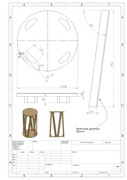- This topic has 4 replies, 3 voices, and was last updated 7 years, 8 months ago by
 Stefanosky.
Stefanosky.
-
AuthorPosts
-
22 July 2017 at 18:33 #10155
Taking as an example the image of the work table used by some American glass scrapers, I thought about making a 3D copy with Solidoworks to see that everything fits and to have the measurements of the cuts in black and white, of the corners, of dimensions etc.
Given that in my opinion it was an excellent job and that the project makes the table in question very stable, I gladly share it with you… Maybe it could be useful to someone.
At the moment I just need to apply a couple of coats of primer and do the adjustable support system for the blank which I will do this week.. It is obvious that the table will need to be ballasted inside to obtain the desired stability.
I made it with a diameter of 50cm and a height of 85cm because they are the measurements that I considered most correct but nothing prevents you from adapting it as you see fit. I certainly couldn't put a drum of oil in my house, Otherwise who would have heard his wife!Notes for assembly:
Use both screws and glue to secure the various parts.23 July 2017 at 0:42 #10158I always have doubts about the base
 23 July 2017 at 9:08 #10159
23 July 2017 at 9:08 #10159What do you mean?
23 July 2017 at 22:06 #10160I see that the 8 stays will make the entire structure of the cylinder that makes up the table very rigid.
I make an argument a “freewheel”, and as regards the round base, I would look for a way to delegate not all of its base surface to contact with the ground, but let it touch the ground with three points on its circumference, or simulate the use of the classic ex oil drum which (although in theory), touch the floor with (some random points) of its raised edge which, however, are found only on its circumference, while a completely flat surface could touch the ground with points even very close to each other, and therefore make everything more swaying.
All this in theory to be experimented. But then, to correct any flaws in contact with the floor usually compensates for a good ballast equal to the weight of the person “will scratch”.
Clearly such a ballast has a volume that can be important (I used my brick weight) and it depends on the objects you can use to form that ballast, who will have to stay still and contained on the base of the table.
23 July 2017 at 22:55 #10162Actually the base with the ballast inside, eg bricks, it adapts to the floor and has no movement whatsoever… With felt pads scattered here in the tiles of the house it is perfect. However I could also put on some feet but at the moment I don't feel the need.
-
AuthorPosts
- You must be logged in to reply to this topic.

